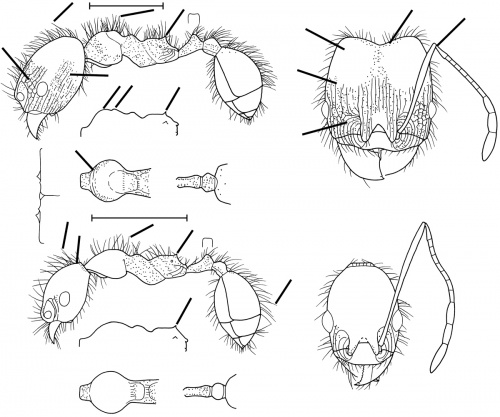Pheidole lupus
| Pheidole lupus | |
|---|---|
| Scientific classification | |
| Kingdom: | Animalia |
| Phylum: | Arthropoda |
| Class: | Insecta |
| Order: | Hymenoptera |
| Family: | Formicidae |
| Subfamily: | Myrmicinae |
| Tribe: | Attini |
| Genus: | Pheidole |
| Species: | P. lupus |
| Binomial name | |
| Pheidole lupus Wilson, 2003 | |
Nothing is known about the biology of lupus.
Identification
See the description in the nomenclature section.
Keys including this Species
Distribution
Only known from the type locality.
Latitudinal Distribution Pattern
Latitudinal Range: -0.6364° to -11.98293°.
| North Temperate |
North Subtropical |
Tropical | South Subtropical |
South Temperate |
- Source: AntMaps
Distribution based on Regional Taxon Lists
Neotropical Region: Ecuador, Peru (type locality).
Distribution based on AntMaps
Distribution based on AntWeb specimens
Check data from AntWeb
Countries Occupied
| Number of countries occupied by this species based on AntWiki Regional Taxon Lists. In general, fewer countries occupied indicates a narrower range, while more countries indicates a more widespread species. |

|
Estimated Abundance
| Relative abundance based on number of AntMaps records per species (this species within the purple bar). Fewer records (to the left) indicates a less abundant/encountered species while more records (to the right) indicates more abundant/encountered species. |

|
Biology
Castes
Nomenclature
The following information is derived from Barry Bolton's Online Catalogue of the Ants of the World.
- lupus. Pheidole lupus Wilson, 2003: 320, figs. (s.w.) PERU.
Unless otherwise noted the text for the remainder of this section is reported from the publication that includes the original description.
Description
A member of the “jujuyensis complex” of the larger fallax group, comprising Pheidole araneoides, Pheidole cuevasi, Pheidole durionei, Pheidole jujuyensis, Pheidole kugleri, Pheidole leonina, Pheidole leptina, Pheidole lucretii, Pheidole lupus, Pheidole paraensis, Pheidole punctithorax, Pheidole tijucana, Pheidole wallacei and Pheidole wolfringi. P. lupus is distinguished as follows.
Major: antennal scape just reaches occipital corner; rugoreticulum on each side of head runs in a swath from eye to antennal fossa; carinulae extend no further than halfway from level of eye to level of occiput; in full-face view occiput and narrow zone running from it around midline foveolate; pronotal dorsal profile in dorsal-oblique view bilobate; propodeal spines small, equilaterally triangular; pilosity very dense and long, many hairs as long as Eye Length.
Minor: pilosity very dense and long, many hairs as long as Eye Length; propodeal spines reduced to denticles; occiput drawn into neck, with nuchal collar.
Measurements (mm)_Holotype major: HW 1.16, HL 1.28, SL 1.06, EL 0.24, PW 0.64. Paratype minor: HW 0.54, HL 0.74, SL 1.00, EL 0.20, PW 0.40.
Color: Major: body dark brown except for head anterior to eyes, which is medium reddish brown; mandibles medium reddish brown; other appendages yellowish brown.
Minor: body medium brown; appendages light brown except for tarsi, which are yellow.
Figure. Upper: holotype, major. Lower: paratype, minor. Scale bars = 1 mm.
Type Material
PERU: Estácion Biologica de Cocha Cashu, Madre de Dios, 400 m, col. Diane W. Davidson. Museum of Comparative Zoology
Etymology
L lupus, wolf.
References
- Wilson, E. O. 2003. Pheidole in the New World: A dominant, hyperdiverse ant genus. Harvard University Press, Cambridge, MA. (page 320, fig. major, minor described)
References based on Global Ant Biodiversity Informatics
- Bezdeckova K., P. Bedecka, and I. Machar. 2015. A checklist of the ants (Hymenoptera: Formicidae) of Peru. Zootaxa 4020 (1): 101–133.
